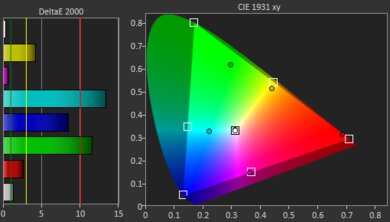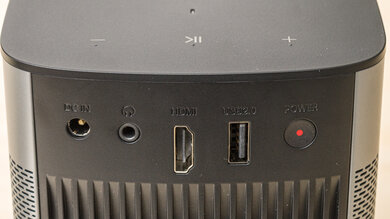The XGIMI Halo+ is a 1080p HDR10/HLG projector. The projector comes with a full suite of image correction technologies, including autofocus, intelligent screen adjustment, and auto keystone correction with object avoidance, so it compensates for any geometry errors in the image automatically. It adjusts itself when it detects objects in the frame. It has Android TV with Chromecast and AirScreen built-in and supports Bluetooth 5.0/BLE and Wi-Fi. It has one HDMI port and can passthrough advanced audio formats from DTS and Dolby through eARC. Finally, it has two integrated 5W Harman/Kardon speakers.
Our Verdict
The XGIMI Halo Plus is unremarkable for watching movies. It has okay contrast but mediocre peak brightness, so it looks its best in dark rooms, even with its visibly raised blacks. Unfortunately, this projector's pre-calibration accuracy is quite poor, but you can greatly improve its image accuracy with the limited calibration options. It has a wide color gamut, although the projector isn't bright enough to make its colors truly pop.
-
Full suite of smart features and wireless connectivity options.
-
Extremely portable due its small size and integrated battery.
-
Poor pre-calibration color accuracy, so you really need to calibrate this projector if you care about color accuracy.
- 6.3 Movies
Changelog
- Updated May 21, 2024: Updated text throughout the review according to Test Bench 0.9, mainly in the Verdict, Compared To Other Projectors and Contrast sections.
- Updated May 21, 2024: We've converted this review to Test Bench 0.9. We've overhauled our Contrast tests, as we now measure contrast at various average pixel levels (APL). You can see the full changelog here.
- Updated Feb 23, 2024: Review published.
- Updated Feb 17, 2024: Early access published.
Check Price
Differences Between Sizes And Variants
We tested the XGIMI Halo projector, which succeeds the XGIMI Halo. The newer Halo Plus has a higher brightness rating than its predecessor, has MEMC motion smoothing technology, and can passthrough DTS-HD and DTS-Studio Sound through its eARC port.
| Model | Brightness | MEMC | ARC/eARC |
|---|---|---|---|
| XGIMI Halo+ | 700 lumens | Yes | eARC |
| XGIMI Halo | 600 lumens | No | ARC |
You can see the label here.
Compared To Other Projectors
The XGIMI Halo Plus is unremarkable for watching movies but is a good choice at its price point as it's better than other similarly priced portable projectors like the Samsung The Freestyle 2nd Gen or the Anker Nebula Capsule 3. Still, if you don't need an integrated battery, the XGIMI Elfin is almost as good and a bit cheaper.
Check out our recommendations for the best portable projectors, the best outdoor projectors, and the best home projectors. If you'd prefer to shop for another product in the same price range, look up the best projectors under $1,000 instead.
The XGIMI HORIZON and XGIMI Halo+ serve different purposes, with the Halo+ being much more portable due to its size, weight, and integrated battery, although the HORIZON can also be moved around easily if needed. The HORIZON is much brighter, so it can handle a few lights in the room, but the Halo+ has slightly better contrast, so it looks a bit better in dark rooms.
The XGIMI Halo+ is better than the XGIMI MoGo 2 Pro. The Halo+ is slightly bigger and heavier than the very light MoGo 2 Pro, but it has an integrated battery, making the Halo+ more portable than the MoGo 2 Pro. The Halo+ is also significantly brighter, with slightly better contrast, so it projects a more attractive, vibrant image. The Halo+ also has an eARC port, so it can passthrough more advanced audio formats than the MoGo 2 Pro can through its ARC port.
The XGIMI Halo+ is much better than the Anker Nebula Capsule 3 Laser. The XGIMI is much brighter, has better contrast, and has a much wider color gamut, so it projects a more vibrant image than the Anker. The Anker is more accurate than the XGIMI but not nearly enough to compensate for the XGIMI's edge in image quality.
The XGIMI Halo+ is better than the Samsung The Freestyle 2nd Gen. The XGIMI is much brighter and has better contrast than the Samsung, so it projects a much more vibrant image. The Samsung is, however, vastly more accurate than the XGIMI, so you might prefer it if you care about image accuracy.
The XGIMI Halo+ is a bit better than the XGIMI Elfin, but unfortunately, the Halo+ really needs to be calibrated if you care about image accuracy, as it is inaccurate otherwise. Still, the Halo+ has better brightness and contrast than the Elfin, a slightly wider color gamut, and is even more portable due to the inclusion of an integrated battery.
The XGIMI HORIZON Pro is slightly better than the XGIMI Halo+, although the Halo+ is the more portable projector due to its lighter weight and integrated battery. Outside of portability, both projectors have similar characteristics, although the HORIZON Pro projects a sharper image due to its pixel-shifting technology. The HORIZON Pro is also brighter than the Halo+, but the Halo+ has slightly better contrast.
The Epson EpiqVision Mini EF12 and XGIMI Halo+ have different strengths. They're both small and light projectors, but the XGIMI is even smaller, and it has an integrated battery, making it more portable than the Epson. Regarding image quality, the XGIMI has better contrast and a wider color gamut than the Epson, but the Epson is the vastly more accurate projector. Thus, the XGIMI is better suited for contexts where image accuracy doesn't matter as much, like projecting on the side of a van when camping. The Epson is better if you can access an outlet and project on a good-quality screen.
The XGIMI Halo+ is much better than the Anker Nebula Capsule Max. They're both small portable projectors, although the Anker is smaller than the already small XGIMI. However, the XGIMI offers better image quality due to its much higher peak brightness and superior color accuracy. The XGIMI also projects a sharper 1080p image, while the Anker is limited to 720p. The XGIMI is also cast capable and even has an eARC port in case you want to connect a soundbar.
The XGIMI HORIZON Ultra is much better than the XGIMI Halo+, but they serve different purposes. The Halo+ is a small portable projector with an integrated battery, so it's meant to be carried around. The HORIZON Ultra is a bigger and heavier projector with far superior image quality, but it's also much more expensive than the Halo+.
The XGIMI Halo+ is better than the XGIMI MoGo 2, although, unfortunately, the Halo+'s pre-calibration accuracy is much worse than the MoGo 2's already inadequate accuracy. Thankfully, you can improve the Halo+'s accuracy significantly through calibration. The Halo+ has otherwise better image quality, better brightness and contrast, a slightly wider color gamut, and projects a sharper 1080p resolution image versus 720p for the MoGo 2. The Halo+ also has an integrated battery, making it even more portable than the cheaper MoGo 2.
The XGIMI Halo+ is far better than the LG CineBeam PF50KA. The XGIMI is even more portable due to its full suite of image correction features while being noticeably brighter. The XGIMI projector also has better contrast than the LG, making it the better choice for any room condition.
Test Results
The projector has a fairly lightweight design and has an integrated battery, so it's easy to carry around. It has full auto keystone correction, autofocus, intelligent screen alignment, and obstacle avoidance, so you don't need to do manual image corrections on this projector, making it easy to set up. The projector has two 5W Harman/Kardon speakers, so you won't need to worry about connecting it to a soundbar or audio system when bringing it with you.
This 1080p DLP projector uses an LED bulb as its light source, and it is rated for up to 25,000 hours by the manufacturer, so you likely won't ever have to worry about replacing it.
The projector's peak brightness is mediocre. It's bright enough to look good in a dark room, but it's too dim for a pleasant viewing experience when a few lights are present. It has fantastic brightness uniformity, so the sides of the projection don't show any noticeable differences in brightness when compared to the center. If you're not satisfied with this level of brightness, check out the brighter XGIMI HORIZON instead.
This projector has an okay contrast ratio, leading to a somewhat pleasant viewing experience in dark rooms, although it does have visibly raised blacks.
This projector has poor pre-calibration color accuracy. Most colors have extremely noticeable accuracy errors, sometimes even looking like totally different colors than they should be, and the projector's white balance is completely off; reds and blues are overrepresented in all shades of gray, more so in the whites. The projector's color temperature is good, although it is too warm out of the box.
The XGIMI Halo Plus only has 1-point white balance calibration, but it's enough to significantly improve the projector's color accuracy. After calibration, colors still show many accuracy errors, but the white balance is fantastic, and the color temperature is almost right on target.
The projector has a wide color gamut. It covers nearly all of the Rec. 709 color space used with SDR content, although its blues, purples, and reds are inaccurate. It also does a decent job with the wider Rec. 2020 color space.
Comments
XGIMI Halo+: Main Discussion
Let us know why you want us to review the product here, or encourage others to vote for this product.
- 10-100
The quality of LG monitors is poor, when I press on this panel with my fingers slightly on its panel, I can see how the screen bends, like paper, WTF lg are poor or what.
Update: Tested the monitor’s compatibility with 1440p on the PS5, but it doesn’t work.
























